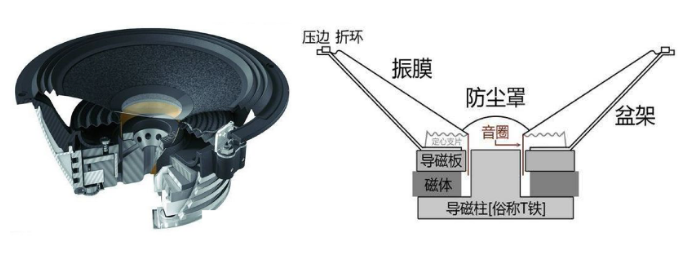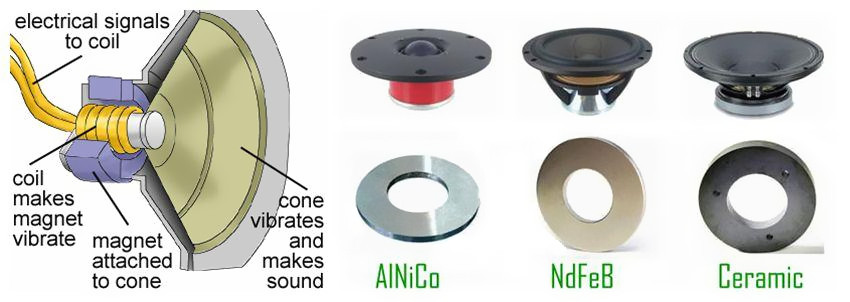
Magnetic materials in speakers (horns)
China NdFeB Magnet Wholesale Strong Magnet Sintered Rare Earth Permanent Neodymium Speaker Magnet
The core component responsible for producing sound in audio equipment is the speaker, commonly known as the speaker, whether it is a speaker or a headset, this key component is indispensable. The loudspeaker is a kind of transducer device that transforms the electric signal into the acoustic signal. The performance of the loudspeaker has a great influence on the sound quality, and the magnet in the loudspeaker largely determines its performance.
The speaker is composed of T iron, magnet, voice coil and diaphragm. When the AC current passes through the coil (voice coil) of the horn, a corresponding magnetic field is generated in the voice coil. This magnetic field interacts with the magnetic field generated by the magnet on the horn. This force makes the voice coil in the horn freely. The magnetic field of the permanent magnet vibrates with the audio current. The diaphragm and the voice coil are connected together. When the voice coil and the horn diaphragm vibrate together, they push the surrounding air to vibrate, and the speaker produces sound. As shown in the picture above, this is the principle of horn sound.

The influence of magnet performance on the sound output quality of speakers
In the case of the same magnet volume and the same voice coil, the performance of the magnet has a direct effect on the sound quality of the speaker:
The greater the magnetic flux density (magnetic induction intensity) B of the magnet, the stronger the thrust acting on the sound film.
The greater the magnetic flux density (magnetic induction) B, the higher the relative power and the higher the sensitivity of the speaker.
The earphone sensitivity is the sound pressure level that the earphone can emit when a sine wave of 1mw and 1khz is input to the earphone. The unit of sound pressure is dB (decibel). The greater the sound pressure, the greater the volume, so the higher the sensitivity, the lower the impedance, and the easier it is for headphones to produce sound.
The greater the magnetic flux density (magnetic induction) B, the lower the overall quality factor Q of the speaker. Q value (quality factor) refers to a set of parameters of horn damping coefficient,
The greater the magnetic flux density (magnetic induction) B, the better the transient.
Transient can be understood as "fast response" to the signal. Headphones with good transient response should respond immediately as soon as the signal comes, and stop abruptly as soon as the signal stops. It will never be sloppy. It can be played by drums and symphonies with larger scenes. The transition part of the ensemble is most obvious.
How to choose a horn magnet
The speaker magnets on the market mainly include AlNiCo, ferrite and neodymium iron boron:
Alnico magnet is the earliest magnet used in speakers, such as the horn speakers in the 1960s (known as tweeters). Generally made into internal magnetic horn (external magnetic type is also available). The disadvantage is that the power is small, the frequency range is narrow, hard and brittle, and processing is very inconvenient. In addition, cobalt is a scarce resource, and the price of AlNiCo is relatively high. From the perspective of cost performance, horn magnets choose AlNiCo.
Ferrite magnet is generally made of external magnetic speakers. Ferrite has relatively low magnetic performance and requires a certain volume to meet the driving force of the speaker. Therefore, it is generally used in larger audio speakers. The advantage of ferrite is that it is cheap and cost-effective; the disadvantage is that it is larger in size, smaller in power, and narrow in frequency range.
The magnetic properties of NdFeB magnets are far superior to AlNiCo and ferrite. It is currently the most used magnet on speakers, especially high-end speakers. Its advantages are its small size, high power, and wide frequency range under the same magnetic flux. At present, HiFi headphones basically use such magnets. The disadvantage is that because it contains rare earth elements, the material price is relatively high.

Thank you for reading our article and we hope it can help you to have a better understanding of the most commonly used permanent speaker magnets. If you want to learn more about rare earth magnets, we would like to advise you to visit BEARHEART Magnets for more information.
We can provide high-quality permanent magnets like neodymium magnets, ferrite magnets and magnetic assembly at a very competitive price. Any inquiries and orders are welcomed.
